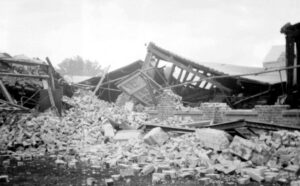
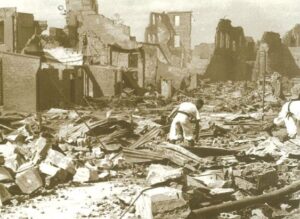 February 3, 1931, dawned beautiful and calm in Hawke’s Bay, New Zealand, but by the end of the day, few people would be thinking of how the day had started out. At exactly 10:47am the hands of the clock on the band rotunda in Napier stopped turning. That was the moment when the area was hit by a massive 7.8 magnitude earthquake. The quake shook the area for a full three minutes, causing such destruction that it actually changed the topography of the area forever. Buildings were leveled, streets were destroyed, fires broke out, power and phone lines were knocked out, and 256 people lost their lives…161 in Napier, 93 in Hastings, and two in Wairoa. Many thousands more were injured. The 1931 Hawke’s Bay earthquake the deadliest natural disaster in New Zealand’s history.
February 3, 1931, dawned beautiful and calm in Hawke’s Bay, New Zealand, but by the end of the day, few people would be thinking of how the day had started out. At exactly 10:47am the hands of the clock on the band rotunda in Napier stopped turning. That was the moment when the area was hit by a massive 7.8 magnitude earthquake. The quake shook the area for a full three minutes, causing such destruction that it actually changed the topography of the area forever. Buildings were leveled, streets were destroyed, fires broke out, power and phone lines were knocked out, and 256 people lost their lives…161 in Napier, 93 in Hastings, and two in Wairoa. Many thousands more were injured. The 1931 Hawke’s Bay earthquake the deadliest natural disaster in New Zealand’s history.
The earthquake left the people in shock, as they surveyed the damage to their beautiful seaside city. People had trouble breathing, due to dust clouds from shattered buildings, and the roads were filled with huge splits making it impossible to get emergency equipment into the area. When the initial shaking began, people ran panic-stricken out of the buildings and into the street. Many of them were killed instantly when they were struck by falling masonry, as stone decorations on many buildings crashed to the ground. Still others were buried alive in the rubble as the buildings collapsed. To make matters worse, fires were burning throughout the city of Napier for a full 36 hours before they could be contained. Most of the surviving buildings from the initial impact of the quake, were leveled by the fires. Nearby Hastings lost approximately 200 buildings and most of the deaths there were in a single department store, although many died in the public library too. Hastings also suffered from out-of-control fires due to problems with their water supply, but fires weren’t as bad as in Napier.
While the earthquake was a major tragedy, there were numerous acts of heroism that will never be forgotten. 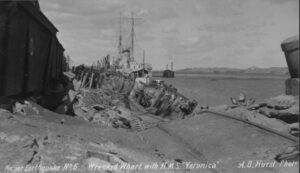 Water for fighting the fires ran out because underground pipes had cracked and broken. Fire engines at Napier’s central fire station were covered in debris from the destroyed brigade building, and they couldn’t be used when fires broke out in the town anyway. Napier Hospital, built only a year earlier, collapsed, claiming the lives of 12 nurses. Rescuers fought to bring out trapped and injured victims from the rubble before the fires reached them. Still, many died in the terrible inferno. With the loss of the Napier Hospital, first responders quickly set up emergency hospitals. Unfortunately, the hospitals lacked the necessary medical supplies, and so the doctors and nurses were limited in what they could do to help the injured. Back-up medical teams were sent from Auckland on board Navy ships and from Wellington by train, but this took time to arrange, and with communication largely out, the communications had to be routed through ships in the harbor, like the HMS Veronica, which had just tied up in the harbor when the quake hit. At first her captain thought there had been an explosion on board…until he saw the wharf twisting and beyond it houses and other buildings crumpling to the ground. It was then that the sickening reality hit him. He quickly sent his sailors ashore to assist with the rescue effort. By the morning of February 4, 1931, the area was filled with rescue workers trying to save anyone they could. Unfortunately, for many, help came too late. Still, a full three days after the quake a 90-year-old man who was buried in the earthquake rubble was finally dug out alive. Miracles do happen.
Water for fighting the fires ran out because underground pipes had cracked and broken. Fire engines at Napier’s central fire station were covered in debris from the destroyed brigade building, and they couldn’t be used when fires broke out in the town anyway. Napier Hospital, built only a year earlier, collapsed, claiming the lives of 12 nurses. Rescuers fought to bring out trapped and injured victims from the rubble before the fires reached them. Still, many died in the terrible inferno. With the loss of the Napier Hospital, first responders quickly set up emergency hospitals. Unfortunately, the hospitals lacked the necessary medical supplies, and so the doctors and nurses were limited in what they could do to help the injured. Back-up medical teams were sent from Auckland on board Navy ships and from Wellington by train, but this took time to arrange, and with communication largely out, the communications had to be routed through ships in the harbor, like the HMS Veronica, which had just tied up in the harbor when the quake hit. At first her captain thought there had been an explosion on board…until he saw the wharf twisting and beyond it houses and other buildings crumpling to the ground. It was then that the sickening reality hit him. He quickly sent his sailors ashore to assist with the rescue effort. By the morning of February 4, 1931, the area was filled with rescue workers trying to save anyone they could. Unfortunately, for many, help came too late. Still, a full three days after the quake a 90-year-old man who was buried in the earthquake rubble was finally dug out alive. Miracles do happen.
Napier was forever changed from this devastating tragedy. The Ahuriri Lagoon and tidal flats that was once a large body of water was completely emptied, and today the area is the site of the Hawke’s Bay Airport. The sea floor just off Hawke’s Bay was lifted approximately 8 feet 10 inches. The main fault, which was buried under the earth’s surface heaved up the land, setting off two smaller faults which broke on the surface. Following the terrible devastation, came resilience and determination in the people, and the area would be rebuilt and 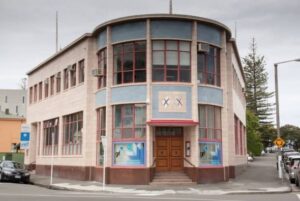
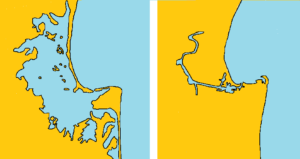 improved. The streets were widened when they rebuilt, and services were improved, including New Zealand’s first underground power system. The architectural fashion of the time was known as Art Deco, and central Napier is almost entirely built in variations of this style. One beautiful legacy from an otherwise tragic chapter of Napier’s history.
improved. The streets were widened when they rebuilt, and services were improved, including New Zealand’s first underground power system. The architectural fashion of the time was known as Art Deco, and central Napier is almost entirely built in variations of this style. One beautiful legacy from an otherwise tragic chapter of Napier’s history.


Leave a Reply